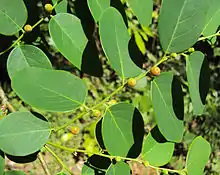Breynia vitis-idaea
Breynia vitis-idaea, the officinal breynia, is a perennial tree-like species of Phyllanthaceae (Euphorbiaceae s.l.), found from India east to Taiwan and Okinawa and south to Indonesia. It is a shrub or treelet with egg-shaped leaves that can reach up to 3 m tall. It has staminate flowers and spherical, red fruit.
| Breynia vitis-idaea | |
|---|---|
 | |
| Scientific classification | |
| Kingdom: | Plantae |
| Clade: | Tracheophytes |
| Clade: | Angiosperms |
| Clade: | Eudicots |
| Clade: | Rosids |
| Order: | Malpighiales |
| Family: | Phyllanthaceae |
| Genus: | Breynia |
| Species: | B. vitis-idaea |
| Binomial name | |
| Breynia vitis-idaea (Burm.f.) C.E.C.Fischer | |
| Synonyms[1] | |
|
List
| |
Breynia vitis-idaea is pollinated by the leafflower moth Epicephala vitisidaea in Fujian, China and the Ryukyu Archipelago, Japan. The moth actively pollinates the flowers, but lays an egg into the space between the external carpel wall and the tepals. The moth caterpillars consume a subset of the tree's seeds, receiving nourishment in return.[2][3]
It contains the saponin breynin and terpenic and phenolic glycosides.[4] It is marketed in Taiwan as Chi R Yun.
Toxicity
Breynia vitis-idaea poisoning causes hepatocellular liver injury.[4]
Other names
Breynia officinalis Hemsley and B. officinalis var. accrescens (Hayata) M.J.Deng & J.C.Wang are synonyms of B. vitis-idaea.
Other variants include:
- Breynia formosana (Hayata) Hayata
- Breynia officinalis Hemsley var. officinalis
- Breynia stipitata Muell. -Arg. var. formosana Hayata
- Breynia stipitata Muell. -Arg. var. formosana Hayata
Other common names in English include:[5]
- Formosan breynia
- Large calyx breynia
- Medicinal breynia
Common names in other languages include:
- Vietnamese: Cù đề
- Min Nan Chinese: 紅心仔 Âng-sim-á, 紅珠仔 Âng-chu-á, 紅仔珠 Âng-á-chu
- Chinese: 七日暈; lit. '7-day dizziness'
- Paiwan: Takaha'do
- Malay: Hujan panas, semomah, seruyan
- Tagalog: Matangulang
- Cebuano: Sungut-olang
- Tausug: Santing
- Thai: เพี้ยะฟาน (phiafān; [pʰíaʔ faːn]), ดับพิษ (dapphit; [dàp pʰít]) (northern), ก้างปลาทะเล (kāngplāthalē; [kâːŋ plaː tʰáʔ leː]), ผักหวานตัวผู้ (phakwāntūaphū; [pʰàk wǎːn tuːa pʰûː]) (central)[6]
- Japanese: 大島小判の木 / オオシマコバンノキ / おおしまこばんのき (Ōshima kobannoki), 台湾小判の木 / タイワンコバンノキ / たいわんこばんのき (Taiwan kobannoki), 姫小判の木 / ヒメコバンノキ / ひめこばんのき (Hime kobannoki), 高砂小判の木 / タカサゴコバンノキ / こばんのき (Takasago kobannoki)
References
- "The Plant List: A Working List of All Plant Species". Retrieved April 3, 2014.
- Kawakita, A.; Kato, M. 2004. Obligate pollination mutualism in Breynia (Phyllanthaceae): further documentation of pollination mutualism involving Epicephala moths (Gracillariidae). American Journal of Botany. 91: 1319–1325.
- Zhang, J., Hu, B., Wang, S. & Li, H. (2012). "Six new species of Epicephala Meyrick, 1880 (Lepidoptera: Gracillariidae) associated with Phyllanthaceae plants." Zootaxa 3275: 43-54.
- J. K. Aronson. Meyler's Side Effects of Herbal Medicines. Elsevier, 2008. p. 119. ISBN 978-0-444-53269-5
- Breynia officinalis Hemsley at Plants of Taiwan.
- ค้นหาข้อมูลพืช (in Thai)